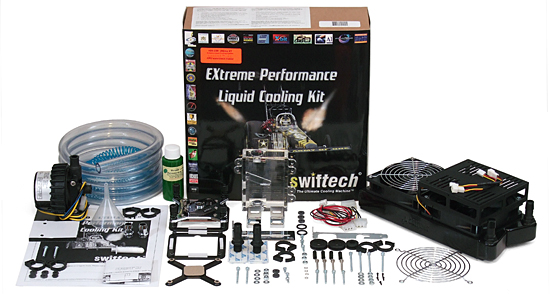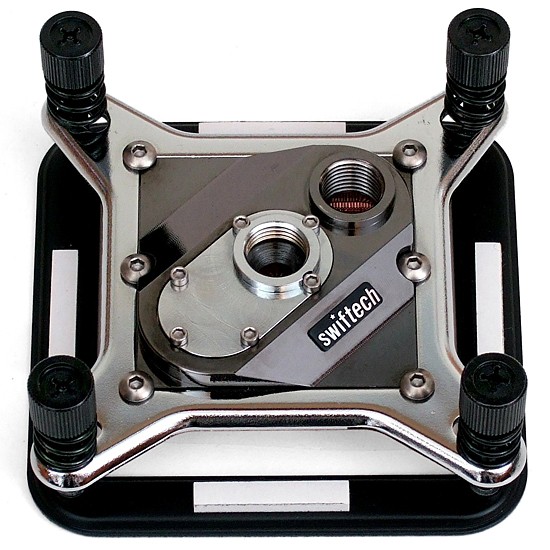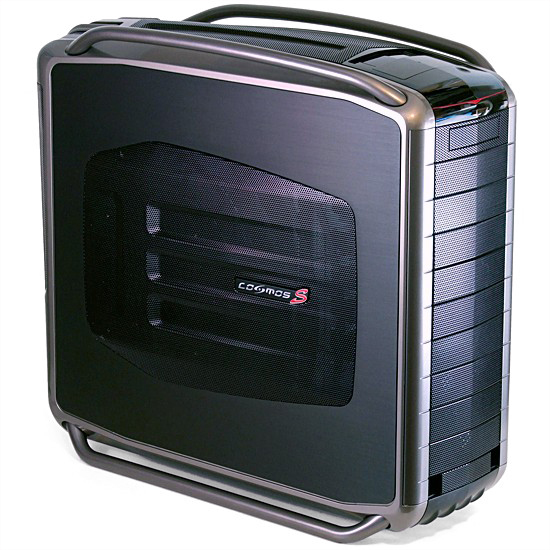System Builder Marathon, March 2010: $3,000 Extreme PC
Cooling And Case
Cooling: Swiftech H20-220 Ultima XT
Heat has always been the enemy of overclocking, but cooling an LGA 1366 processor at over 4.0 GHz and 100% load requires something with a little more capacity than traditional air cooling. Achieving even modest gains from a Radeon HD 5970 graphics card is an even bigger concern, as the manufacturer was already forced to underclock each of its two Radeon HD 5870 graphics processors to assure survival under a reasonably-sized heat sink. Yet, even with our $3,000 limit, building a high-capacity liquid-cooling system could have put a huge dent in the budget of other components.
Read Customer Reviews of Swiftech's H20-200 Apex Ultima Extreme Duty
Swiftech provides the solution with its H20-220 Ultima XT that offers all the parts we’d need at a savings of over $60 compared to separately-purchased components. Swiftech’s kit fits our expandability needs perfectly, as its MCP-655B pump and 0.5” fittings offer enough flow for a system at least twice as complex as ours. And while its high-capacity 2x120mm radiator might be barely big enough for our needs, there’s enough savings in the kit to allow a three-fan radiator upgrade to be purchased separately while still saving money compared to separate components.
The Apogee XT water block is the star of this kit, with a copper base and brass top providing enhanced durability and electrolytic corrosion resistance compared to earlier copper/plastic and copper/aluminum parts.
Case: Cooler Master Cosmos S
External cooling components don’t just look ugly, they also create huge risks when moving a system from place to place. We needed a case that would hold all of our parts internally, and the extended height of our graphics card cooler meant the model used last September simply wouldn’t work. Of the three cases that would hold all our parts appropriately, Cooler Master’s Cosmos S stood out as the best-looking and most flexible.
Read Customer Reviews of Cooler Master's Cosmos S Chassis
The Cosmos S follows our expandability theme by allowing a later upgrade from the current dual-fan to a triple-fan radiator and, as our installation pages will show, it has enough room for nearly any other hardware the end-user might wish to add.
Get Tom's Hardware's best news and in-depth reviews, straight to your inbox.
-
zoemayne More than 64GB is gonna be needed for multiple games and good apps... those ssd's can only handle 5 games max.Reply -
Crashman zoemayneMore than 64GB is gonna be needed for multiple games and good apps... those ssd's can only handle 5 games max.Reply
You're repeatedly ignoring that it's 128GB, not 64GB, because the article repeatedly states that the drives are striped (Level 0) by the RAID controller. And there's a terabyte of added storage on top of that for stuff that isn't programs. -
anamaniac Nice as it is, my only complaint is that...Reply
Overclocked 5970 + i7 on a single 120.2?
ARE YOU MAD!
Likely.
Well, I personally would have dropped something else and gone for a 120.3 or 140.3 radiator. =D
Hell, maybe even a 140.4 radiator, but then again, I like my system to run chilly and silent. It's also be very difficult to mount a 140.4 I assume. Maybe I could jack a radiator form work, I think it's about 1 metre by 3 metres by half a metre. Granted, it's for industrial use, but just for one day, please boss please?
Good results on the i7 though. Decently low voltage and still managed to reach 4.3GHz. My i7 is a lemon. It makes me sad. =(
Also an impressive overclock for a 5970.
At this kind of power, you should be testing multi monitor resolutions. I have a 5770 and I run 7 megapixels, you use a 5970 and only run 4 megapixels.
Looking forward tho the $1,500 build. See how my build compares to one six months older on a similar budget (and cry). -
tacoslave http://www.youtube.com/watch?v=U9l-XQzdRGg&feature=related this is what happened when i saw that 5970 in action "I CAME"Reply -
Crashman Reply9490893 said:Nice as it is, my only complaint is that...
Overclocked 5970 + i7 on a single 120.2?
ARE YOU MAD!
Well, the explanation is in the conclusion, the builder wanted redundant storage instead of the big radiator but chose neither, leaving enough room in the budget for anyone who wanted to copy the build to make their own upgrade choice.
But what's not in the budget is that the water was never hot, it was barely warm. The problem with running the CPU at 100% load and the GPU at 100% load is that the water temperature went up by around 10 degrees...we're talking about going from the 30's to the 40's here at full load. The article points to the GPU cooler as a likely flow restriction so I have three solutions:
Solution 1: Add 1/2" by 3/8" adapter T's and cool the chipset block, parallel to the GPU block. That would allow some of the water to bypass the GPU cooler, which is OK since the GPU was always cold. But 1/2" by 3/8" T's are hard to find outside of a hardware store, and Newegg certainly doesn't have them.
Solution 2: Switch to a 3-fan radiator. A 4-fan unit won't fit nicely into that case, and making an ugly system wasn't considered a solution.
Solution 3: Add a second liquid-cooled 5970 parallel to the first. Get twice the GPU power and completely unblock the lines in the process. The GPUs would run slightly hotter when each gets only half the water, but at least the CPU block's flow won't be restricted. And...since it's probably adding another 10 degrees to the coolant...stick the three-fan radiator in there as well. For FOUR grand you could have a KILLER system!
OK, so solution 1 is the cheapest, but you have to admit solution 3 is tempting...
-
Sihastru I kinda like it. Dramatic power increase for the overclocked components. But also dramatic performance increase.Reply
Another solution to the constricted water flow would be to change the block on the 5970.
This build gets one and a half thumbs up from me, not that anyone cares...






